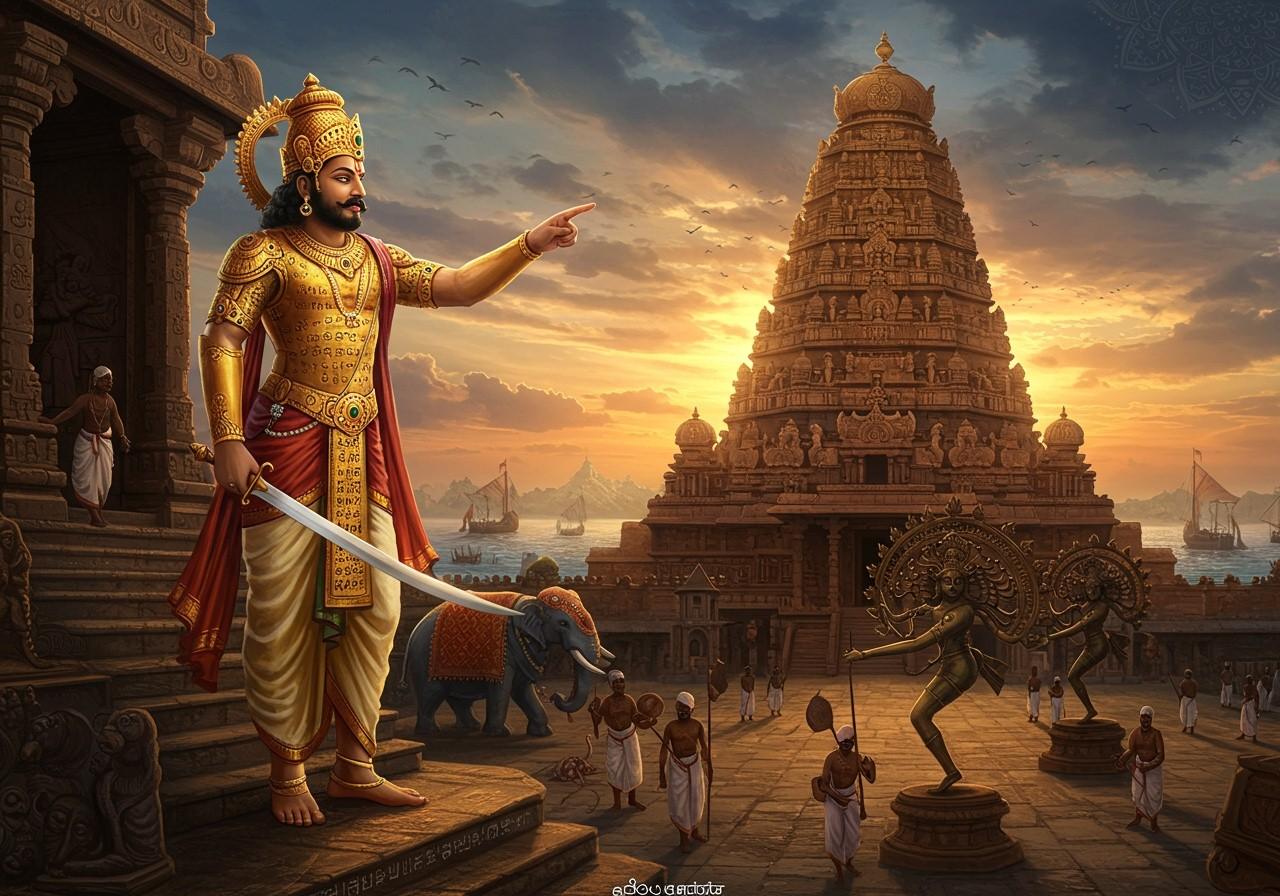
The Chola dynasty, originating from Southern India, experienced its golden age during the Imperial Chola era, particularly under the rule of Rajaraja Chola I (reign: 985-1014 CE) and his successors, including Rajendra Chola I (reign: 1014-1044 CE) and Rajadhiraja Chola (reign: 1018-1054 CE). This period, spanning from the mid-10th to the mid-11th centuries, was marked by significant prosperity, architectural and religious achievements, military and naval power, and a rich cultural heritage, including important contributions to Tamil literature. The Chola Empire expanded significantly, with territories in Sri Lanka, the Maldives, and parts of Southeast Asia, particularly the Malay Peninsula, and had a notable influence in South, Southeast, and East Asia.
Rajadhiraja Chola: A Glimpse into His Reign
Rajadhiraja Chola, reigning from approximately 1018 to 1054 CE, played a crucial role in upholding and expanding the Chola empire’s power and influence. He led successful military campaigns, further solidifying the empire’s dominance in the region. A patron of the arts and architecture, he commissioned the construction of numerous temples, showcasing the architectural prowess of the era. His reign is often considered the peak of Chola power, marked by efficient administration, thriving trade, and agricultural prosperity.
Architectural Marvels: Temples of the Chola Dynasty
The Chola Dynasty is renowned for its magnificent temples, which served as both religious centers and hubs of social and economic activity. These architectural marvels stand as testaments to the dynasty’s artistic and engineering skills. Constructed primarily from locally sourced granite, they exemplify the advanced engineering and craftsmanship of the time.
- Brihadisvara Temple at Gangaikonda Cholapuram: This temple, commissioned by Rajendra Chola I, features intricate carvings and a towering vimana (temple tower), showcasing the characteristic features of Chola architecture. Its scale and artistic detail highlight the empire’s resources and devotion to religious expression.
- Airavatesvara Temple at Darasuram: Another architectural gem, the Airavatesvara Temple, built during the reign of Rajaraja Chola II (1146–1173 CE), further exemplifies the exquisite craftsmanship of Chola artisans. Its elaborate sculptures and intricate stonework are a testament to the dynasty’s artistic legacy.
These temples, along with many others built during the Chola period, continue to inspire awe and serve as important cultural and historical landmarks.
The Importance of Temple Rituals
Temple rituals played a central role in Chola society, serving both religious and social functions. Meticulously documented, these rituals provided guidelines for daily worship, festival celebrations, and other religious observances. Temples also served as centers of learning, attracting Vedic scholars, poets, and artists. They reinforced the Chola kings’ divine right to rule, as they were seen as representatives of the gods on earth. Royal patronage and endowments from wealthy individuals ensured the temples’ continued prosperity.
Cultural Flourishing: Literature, Arts, and Religion
The Chola Dynasty fostered a rich cultural heritage. This era witnessed a flourishing of Tamil literature, with notable works like the Kamba Ramayanam, a Tamil adaptation of the Sanskrit epic Ramayana. Classical dance forms like Bharatanatyam also developed and thrived during this period. The Cholas played a key role in spreading Hinduism and Tamil culture across Southeast Asia, particularly to regions like Cambodia and Indonesia, leaving a lasting impact on the region’s cultural landscape.
Economic Prosperity and Trade Networks
The Cholas established a robust system for agriculture, trade, and commerce. Their strategic location facilitated maritime trade with distant lands, including China, the Srivijaya Empire (modern-day Indonesia), and the Middle East. The empire minted its own coins, which were widely accepted in international trade. Prominent ports like Nagapattinam became bustling centers of commerce, attracting merchants from across Asia. The surplus generated from agriculture and trade revenues fueled the construction of grand temples, public works, and other projects that contributed to the empire’s overall prosperity.
Connecting with Chola Heritage through Poojn.in
Poojn.in offers a wide selection of authentic puja items and temple accessories inspired by the rich cultural heritage of the Chola Dynasty. We provide high-quality products that allow you to connect with and honor the traditions of this era:
- Traditional brass lamps (vilakku): Similar to those used in Chola temples, our handcrafted brass lamps bring a touch of authenticity to your puja rituals. We offer a variety of sizes and designs to choose from.
- Copper and brass vessels: Essential for traditional temple rituals, our pure copper and brass vessels are crafted with precision and care. They are perfect for offerings and other ceremonial practices.
- Handcrafted deity idols: Our deity idols are made using traditional Chola-era techniques, capturing the artistic essence of the period. Choose from a selection of deities, each meticulously crafted with attention to detail.
- Sacred threads and garlands: Enhance your temple worship with our authentic sacred threads and garlands, made from high-quality materials. These items add a touch of tradition and reverence to your puja.
- Kumkum and chandanam: Sourced from Tamil Nadu temples, our authentic kumkum and chandanam are essential for traditional rituals. These sacred powders add a touch of purity and devotion to your worship.
Featured Products:
- Panchaloka Bronze Lamp (5-wick)
- Temple-grade Pure Copper Kalash
- Handmade Cotton Sacred Thread (Pack of 5)
- Traditional Tamil Nadu Temple Kumkum Set
Visit www.poojn.in or call +91 7908548235 to explore our collection and order these authentic ritual items. We offer secure packaging and delivery across India.
The Enduring Legacy of the Cholas
The Chola Dynasty’s golden age remains a shining example of cultural, architectural, and economic achievement. Their contributions to art, architecture, literature, and trade have left an indelible mark on South India and beyond. The majestic temples, intricate sculptures, and vibrant cultural traditions continue to inspire and resonate with people today. The Chola legacy serves as a testament to the power of vision, innovation, and a deep-rooted connection to tradition. Explore more about Hindu sacred architecture and rituals on poojn.in: Hindu Sacred Architecture, Diwali Puja Guide, Easy Ganesh Puja at Home, Navratri Puja Guide, and Dravidian Temple Architecture.


